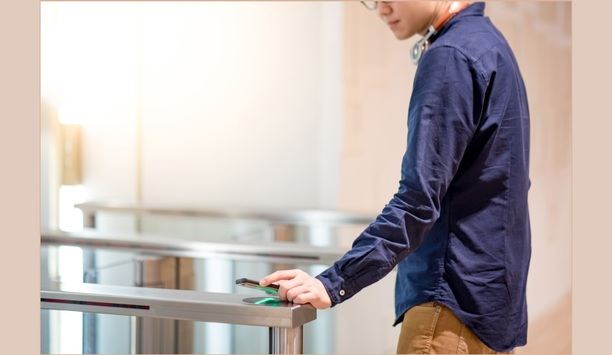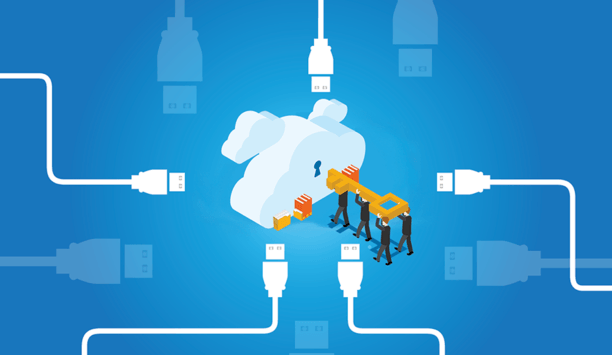Door access control - Expert commentary
You are not alone: operators everywhere are asking themselves what are they going to do? How are they going to get back to business, and fast? How are they going to cost-effectively operate with all the new safety requirements that have arisen as a result of COVID? How are they going to ensure it all gets done for the safety of customers and staff? How are they going to protect their brand from the negative exposure of being identified as a property with a reputation for COVID? The economic imp...
The safeguarding of premises through the monitoring of entrance and exit points has traditionally been a very manual aspect of security. Human operators have been relied on to make decisions about who to admit and deny based on levels of authorisation and the appropriate credentials. But the access control business, like many industries before it, is undergoing its own digital transformation; one where the protection of premises, assets and people is increasingly delivered by interconnected sys...
The emergence of smartphones using iOS and Android is rapidly changing the landscape of the IT industry around the world. Several industries, such as digital cameras, car navigation, MP3, and PNP, have been replaced by equivalent or even better performance using smartphones. Smartphones provide increasing portability by integrating the functions of various devices into a single unit which allows them to connect to platforms with network-based services and offer new services and conveniences that...
Leap years occur every four years as a way to help synchronise the calendar year with the solar year, or how long it takes the Earth to orbit the sun. While this is necessary, leap years require our security systems to account for an extra day, apart from its normal schedule. As a result, leap years create problems with computing and can cause major issues to access control system functionality if a provider is not leap year compatible. There are a few things to keep in mind as we near February...
Back in the 1960s a lead engineer working in conjunction with the United States Navy for Lockheed’s Skunk Works team coined the acronym KISS, which translated to the design principle ‘keep it simple stupid’. The KISS principle embraces the concept of simplicity, stating that most systems work best if they are kept simple rather than geared up to be more complicated. When it comes to physical security systems, this concept can also play a key element in its overall succes...
Two of the most familiar names in the physical security market – Pelco and Panasonic – underwent ownership changes during 2019. Consolidation continued on multiple other fronts. Security service companies, video companies and access control companies were all among the entities involved in merger and acquisition (M&A) activity during the last 12 months. In short, the industry landscape continues to transform in response to a changing market. Here's a look at the Top 10 M&A s...
The statistics are staggering. The death tolls are rising. And those who now fear environments that were once thought to be safe zones like school campuses, factories, commercial businesses and government facilities, find themselves having to add the routine of active-shooter drills into their traditional fire drill protocols. The latest active shooter statistics released by the FBI earlier this year in their annual active-shooter report designated 27 events as active shooter incidents in 2018...
There’s no question that the popularity of Do-It-Yourself (DIY) security and home automation products is on the rise. The reasons for the growth in DIY sales are numerous, including increased awareness of home automation products, fast set-up, limited (if any) installation costs, and interoperability with other smart security products. In fact, with the parallel rise of smart home hubs like Alexa and Google Home, many people are opting to attempt the set-up of smart home devices without an...
Today’s security industry technology standards create a common framework for achieving predictable performance. Systems are made more secure and easier to install, use and integrate with other devices. Standards are also intended to be living documents, open to continual refinements to benefit manufacturers, integrators and end users. An excellent example is the Open Supervised Data Protocol (OSDP), which is now the industry’s gold standard for physical access control installations....
It’s not surprising that people are nervous about the security of newer technologies, many of which are part of the Internet of Things (IoT). While they offer greater efficiency and connectivity, some people still hesitate. After all, there seems to be a constant stream of news stories about multinational corporations being breached or hackers taking control of smart home devices. Both of these scenarios can feel personal. No one likes the idea of their data falling into criminal hands. A...
It amazes me how in a few short years security systems have gone from simple, dumb cameras witnessing events to intelligent eyes, ears, speech and touch solutions that boost situational awareness far beyond human capabilities. It seems the only senses missing from the equation now are smell and taste. And who knows, someone might be working on those in a lab somewhere right now. But what’s really fascinating to me is how the Internet of Things (IoT) has opened a world of possibilities for...
The basic principles of access control are well established: only authorised people should have access to secure areas, only at times that can be defined in advance, and only within a system that can identify exactly who went where, and when. Traditional mechanical lock-and-key systems cannot accomplish this — at least, not without loading a huge admin burden onto security staff. But modern, electronic wireless access control has the flexibility to achieve it. What criteria determine the...
Market dynamics are changing the U.S. residential security market, creating new business models that better appeal to the approximately 70% of households without a security system. Smart home adjacencies have helped revitalise the traditional security industry, and alternative approaches to systems and monitoring for the security industry are emerging, including a new batch of DIY systems. Growth in the residential security market and its position as the channel for smart home solutions have at...
Whether you are a veteran in the access control world or have never installed a card reader before, there are always ways to increase profits in the ever-evolving world of access control. The hope is that by considering a few key focal points, you can find ways to increase market share. Whether we are releasing an electronic lock through a simple intercom button or using biometric and multi-authentication based on a database; the tactics for bringing on more revenue is the same. Learning to focu...
As we approach National Safe Schools Week (October 21-27), it is appropriate for a conversation to begin regarding establishing standards for K12 school security. Currently no standards exist for assisting schools navigate the complexity of understanding what they need, how much it will cost and how they will secure their learning environments. Security industry experts The Partner Alliance for Safer Schools (PASS) is one of the organisations at the forefront of establishing security standards...
If you’re responsible for a medium or large-sized office, it’s more important than ever that you have access to a means of ensuring people’s safety, managing risks and fraud, and protecting property. Any security system that you employ must therefore meet the most demanding commercial requirements of today’s offices, and tomorrow’s. This means thinking beyond a basic intrusion system and specifying a comprehensive solution that integrates smart features like access...
Considering how much the modern smartphone has become a common everyday tool and cultural icon, it’s hard to believe it has only been with us for a relatively short space of time. The first Apple iPhone was launched in 2007 and yet in a little over a decade the smartphone has become as essential as our keys or wallet. From its conception as a multi-faceted communications device, it has morphed into something far more integrated in our daily lives. Services such as Apple Pay, Android Pay a...
Over the past few years, biometrics has rapidly expanded into consumer applications, like the financial market for customer authentication, to payment services and withdrawing cash from ATMs in high-fraud markets. However, its adoption as an additional authentication factor for physical access control systems (PACS) and other enterprise applications, hasn’t been as rapid. But this is changing. Biometrics offers numerous benefits at the door and throughout the enterprise. With the advent o...
With the ever-growing availability of video data thanks to the low cost of high-resolution video cameras and storage, artificial intelligence (AI) and deep learning analytics now have become a necessity for the physical security industry, including access control and intrusion detection. Minimising human error and false positives are the key motivations for applying AI technologies in the security industry. What is artificial intelligence? Artificial intelligence is the ability of machines to...
Until recently, the convenience and security of “smart” electronic locks have been exclusively enjoyed by owners of homes, with renters largely being left out in the cold. Locked out by the temporary nature of their living arrangement, and not allowed to make structural changes to their temporary abodes, these renters have been unable to enjoy the many benefits of these connected devices. But today, smart lock capabilities are becoming available to renters and rental property owners...
When asked about what the market should be thinking about in 2018, I am left offering an answer that serves as an urgent call to action: prepare yourself for change! The security industry is soon likely to see a dramatic shift from the traditional segmentation of commercial and residential security. Smart phones, mobile technologies, cloud computing, and having everything provided ‘as a service’ in peoples’ lives means users of buildings have a new set of expectations. In many...
Today’s security professionals are tasked with protecting the entirety of a facility or campus from every possible threat. It’s a big task, given the range of solutions available; from cybersecurity to prevent hacking, to video surveillance to monitor the goings-on within the facility, to the physical security of the building itself. For most businesses and schools, keeping the entrances and exits to a building secure is an extremely high priority—when an individual cannot ge...
In 2017, SALTO Systems led the market with increased emphasis on two growing sectors within access control: Mobile technology and cloud solutions. Strengthening market positions Mobile access control applications are now a must across all security verticals. The hospitality sector, for example, is quickly seeing smartphones replacing room keys and check-in lines with mobile apps like SALTO’s JustIN Mobile. This technology replaces the need for an access card by securely sending a mobile...
The optical speed lane and turnstile sector of the security market has had a very busy 2017. Growth in commercial construction has provided more opportunity. Innovations in technology have given speed lane manufacturers an opportunity to deliver a better product. Orion sales increase and company growth Orion Entrance Control, Inc., had a great 2017 as sales increased and our company grew. We attribute our success to the unique approach we have taken since day one: providing customised pr...
Students consider many factors when choosing where to study and to live. Undoubtedly, they are increasingly aware of their security needs. Halls of residence that work in tandem with modern lifestyle technologies are attractive to this new generation of students. Simply installing some basic PIN-pads at communal entrances, with no intelligent access control back-up, is little better than a wide open door. The real key is electronic access control. This white paper from ASSA ABLOY&nb...
Rapid changes in the physical security market this year have largely overshadowed one arena where change has slowed down in 2017 – mergers and acquisitions (M&A). Although there were no “mega-mergers” as in years past (such as Axis-Canon and Johnson Controls-Tyco, M&A activity still made headlines last year on SourceSecurity.com. In 2017, we wrote about M&A news involving companies such as HID Global, Eagle Eye Networks, ADT, and Honeywell. ...
During 2017, we’ve enjoyed stable economic growth for a number of years now; we’re not running into as much resistance for security entrances as we did, say, seven to nine years ago. Hardening perimeters against active shooters Compared to other security products such as cameras and card readers, security entrances are a big investment and considered somewhat of a luxury: during downturns we’re among the first to hit the “cutting room floor.” Now, however, fueled...
In recent years, organisations have transformed the way we prepare, respond to and manage emergency situations globally. Through the rapid uptake of new technologies, organisations can accurately account for their individuals in the event of an emergency and maintain the safety of their employees and visitors. In the event of an emergency in an organisation, an efficient and rapid evacuation is of the utmost importance, as hundreds or thousands of people need to be evacuated as quickly as possi...
Access control and security entrance integration is a specialised discipline. It is true that security entrances require only a dry contact and can integrate with virtually any access control system, but there are some things to be considered when researching the right access control system for your organisation’s security goals. After 21 years’ experience in the security industry—four of those serving as an advisor for security solutions to dozens of Fortune 1000 companies&md...
The smart home market has seen significant growth since 2010. Specifically, less than 0.5% of homes in the American region had connected home devices such as thermostats, lighting, security and entertainment in 2010; by the end of 2017, nearly 12% of households in the region will have connected home devices, an average of six devices per home. The success of smart homes started with professional security providers offering bundled packages, focused mostly on security monitoring. However, due to...
Palm vein recognition
DownloadThe key to unlocking K12 school safety grants
DownloadSelecting the right network video recorder (NVR) for any vertical market
DownloadPhysical access control
DownloadCybersecurity for enterprise: The essential guide to protecting your business
Download


































